Executive Functioning: Lifespan Analysis and Intervention Strategies
VerifiedAdded on 2021/05/13
|7
|1641
|40
Report
AI Summary
This report delves into executive functioning (EF), defining it as the brain's role in impulse control, organization, and learning. It identifies three core components: working memory, mental flexibility, and inhibitory control. The report then examines EF across the lifespan, from early childhood through adolescence and adulthood to old age, highlighting developmental milestones and age-related changes. It explores how working memory can be improved in children through goal-oriented and mentally effortful processes, including the use of visual aids and organizational strategies. Furthermore, the report discusses how to modify activities to support children with exceptionalities, emphasizing strategies like repetition, routine, and the use of visual aids. The conclusion summarizes the key findings, emphasizing the importance of EF and providing practical strategies for enhancing working memory and supporting diverse learners.

1
Executive Functioning
Student's Name:
Institutional Affiliation:
Instructor's Name:
Course:
Date:
Executive Functioning
Student's Name:
Institutional Affiliation:
Instructor's Name:
Course:
Date:
Paraphrase This Document
Need a fresh take? Get an instant paraphrase of this document with our AI Paraphraser
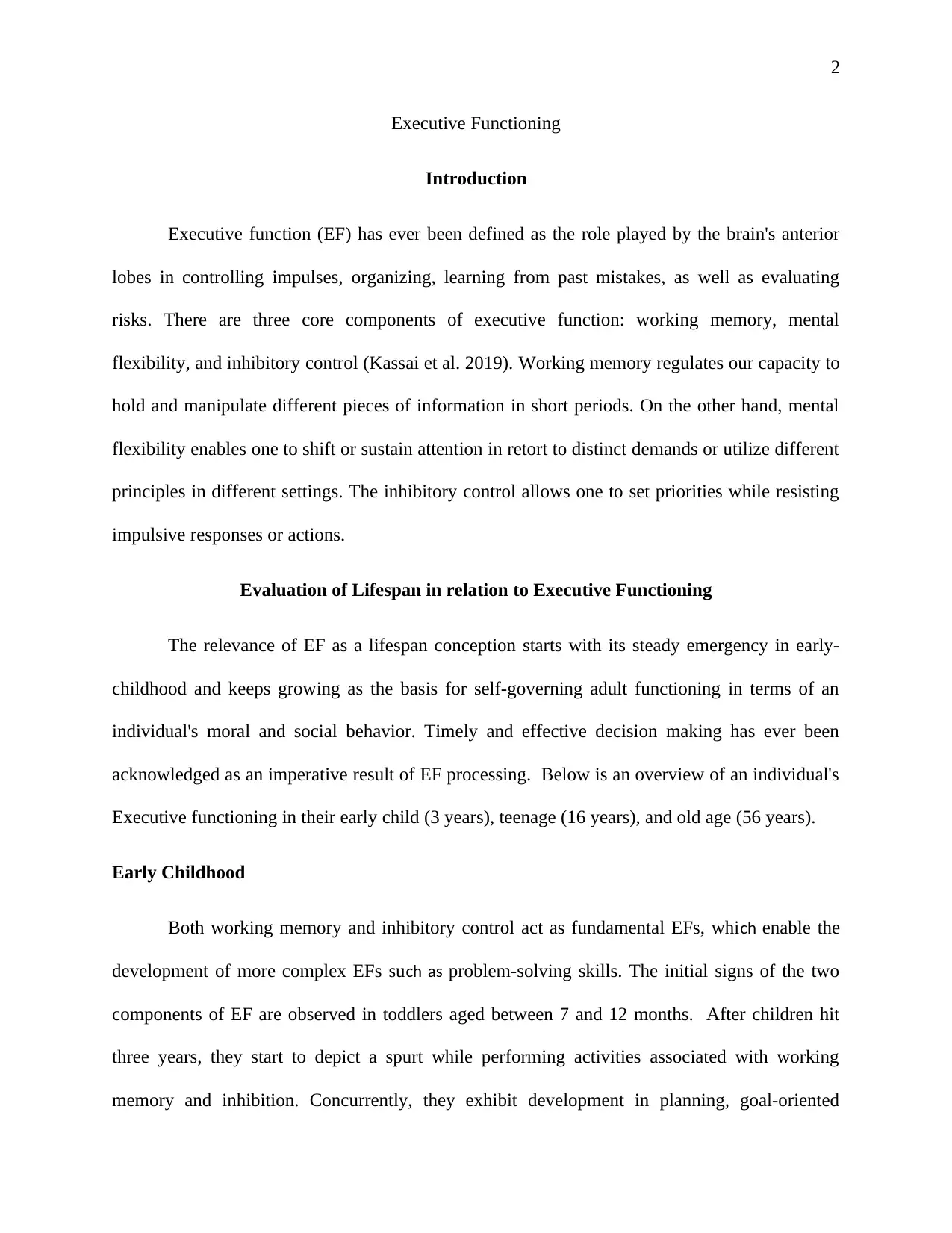
2
Executive Functioning
Introduction
Executive function (EF) has ever been defined as the role played by the brain's anterior
lobes in controlling impulses, organizing, learning from past mistakes, as well as evaluating
risks. There are three core components of executive function: working memory, mental
flexibility, and inhibitory control (Kassai et al. 2019). Working memory regulates our capacity to
hold and manipulate different pieces of information in short periods. On the other hand, mental
flexibility enables one to shift or sustain attention in retort to distinct demands or utilize different
principles in different settings. The inhibitory control allows one to set priorities while resisting
impulsive responses or actions.
Evaluation of Lifespan in relation to Executive Functioning
The relevance of EF as a lifespan conception starts with its steady emergency in early-
childhood and keeps growing as the basis for self-governing adult functioning in terms of an
individual's moral and social behavior. Timely and effective decision making has ever been
acknowledged as an imperative result of EF processing. Below is an overview of an individual's
Executive functioning in their early child (3 years), teenage (16 years), and old age (56 years).
Early Childhood
Both working memory and inhibitory control act as fundamental EFs, which enable the
development of more complex EFs such as problem-solving skills. The initial signs of the two
components of EF are observed in toddlers aged between 7 and 12 months. After children hit
three years, they start to depict a spurt while performing activities associated with working
memory and inhibition. Concurrently, they exhibit development in planning, goal-oriented
Executive Functioning
Introduction
Executive function (EF) has ever been defined as the role played by the brain's anterior
lobes in controlling impulses, organizing, learning from past mistakes, as well as evaluating
risks. There are three core components of executive function: working memory, mental
flexibility, and inhibitory control (Kassai et al. 2019). Working memory regulates our capacity to
hold and manipulate different pieces of information in short periods. On the other hand, mental
flexibility enables one to shift or sustain attention in retort to distinct demands or utilize different
principles in different settings. The inhibitory control allows one to set priorities while resisting
impulsive responses or actions.
Evaluation of Lifespan in relation to Executive Functioning
The relevance of EF as a lifespan conception starts with its steady emergency in early-
childhood and keeps growing as the basis for self-governing adult functioning in terms of an
individual's moral and social behavior. Timely and effective decision making has ever been
acknowledged as an imperative result of EF processing. Below is an overview of an individual's
Executive functioning in their early child (3 years), teenage (16 years), and old age (56 years).
Early Childhood
Both working memory and inhibitory control act as fundamental EFs, which enable the
development of more complex EFs such as problem-solving skills. The initial signs of the two
components of EF are observed in toddlers aged between 7 and 12 months. After children hit
three years, they start to depict a spurt while performing activities associated with working
memory and inhibition. Concurrently, they exhibit development in planning, goal-oriented
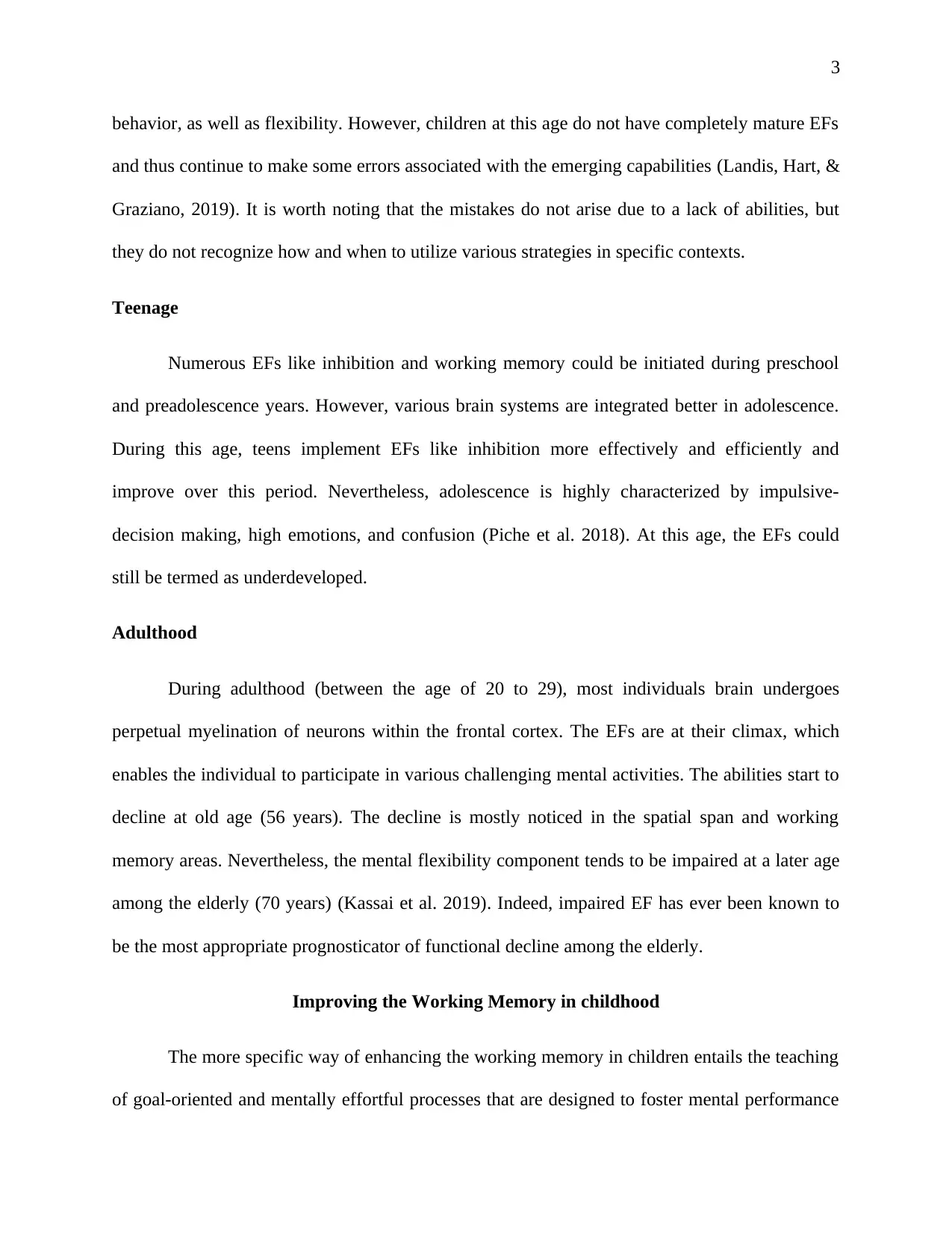
3
behavior, as well as flexibility. However, children at this age do not have completely mature EFs
and thus continue to make some errors associated with the emerging capabilities (Landis, Hart, &
Graziano, 2019). It is worth noting that the mistakes do not arise due to a lack of abilities, but
they do not recognize how and when to utilize various strategies in specific contexts.
Teenage
Numerous EFs like inhibition and working memory could be initiated during preschool
and preadolescence years. However, various brain systems are integrated better in adolescence.
During this age, teens implement EFs like inhibition more effectively and efficiently and
improve over this period. Nevertheless, adolescence is highly characterized by impulsive-
decision making, high emotions, and confusion (Piche et al. 2018). At this age, the EFs could
still be termed as underdeveloped.
Adulthood
During adulthood (between the age of 20 to 29), most individuals brain undergoes
perpetual myelination of neurons within the frontal cortex. The EFs are at their climax, which
enables the individual to participate in various challenging mental activities. The abilities start to
decline at old age (56 years). The decline is mostly noticed in the spatial span and working
memory areas. Nevertheless, the mental flexibility component tends to be impaired at a later age
among the elderly (70 years) (Kassai et al. 2019). Indeed, impaired EF has ever been known to
be the most appropriate prognosticator of functional decline among the elderly.
Improving the Working Memory in childhood
The more specific way of enhancing the working memory in children entails the teaching
of goal-oriented and mentally effortful processes that are designed to foster mental performance
behavior, as well as flexibility. However, children at this age do not have completely mature EFs
and thus continue to make some errors associated with the emerging capabilities (Landis, Hart, &
Graziano, 2019). It is worth noting that the mistakes do not arise due to a lack of abilities, but
they do not recognize how and when to utilize various strategies in specific contexts.
Teenage
Numerous EFs like inhibition and working memory could be initiated during preschool
and preadolescence years. However, various brain systems are integrated better in adolescence.
During this age, teens implement EFs like inhibition more effectively and efficiently and
improve over this period. Nevertheless, adolescence is highly characterized by impulsive-
decision making, high emotions, and confusion (Piche et al. 2018). At this age, the EFs could
still be termed as underdeveloped.
Adulthood
During adulthood (between the age of 20 to 29), most individuals brain undergoes
perpetual myelination of neurons within the frontal cortex. The EFs are at their climax, which
enables the individual to participate in various challenging mental activities. The abilities start to
decline at old age (56 years). The decline is mostly noticed in the spatial span and working
memory areas. Nevertheless, the mental flexibility component tends to be impaired at a later age
among the elderly (70 years) (Kassai et al. 2019). Indeed, impaired EF has ever been known to
be the most appropriate prognosticator of functional decline among the elderly.
Improving the Working Memory in childhood
The more specific way of enhancing the working memory in children entails the teaching
of goal-oriented and mentally effortful processes that are designed to foster mental performance
⊘ This is a preview!⊘
Do you want full access?
Subscribe today to unlock all pages.

Trusted by 1+ million students worldwide
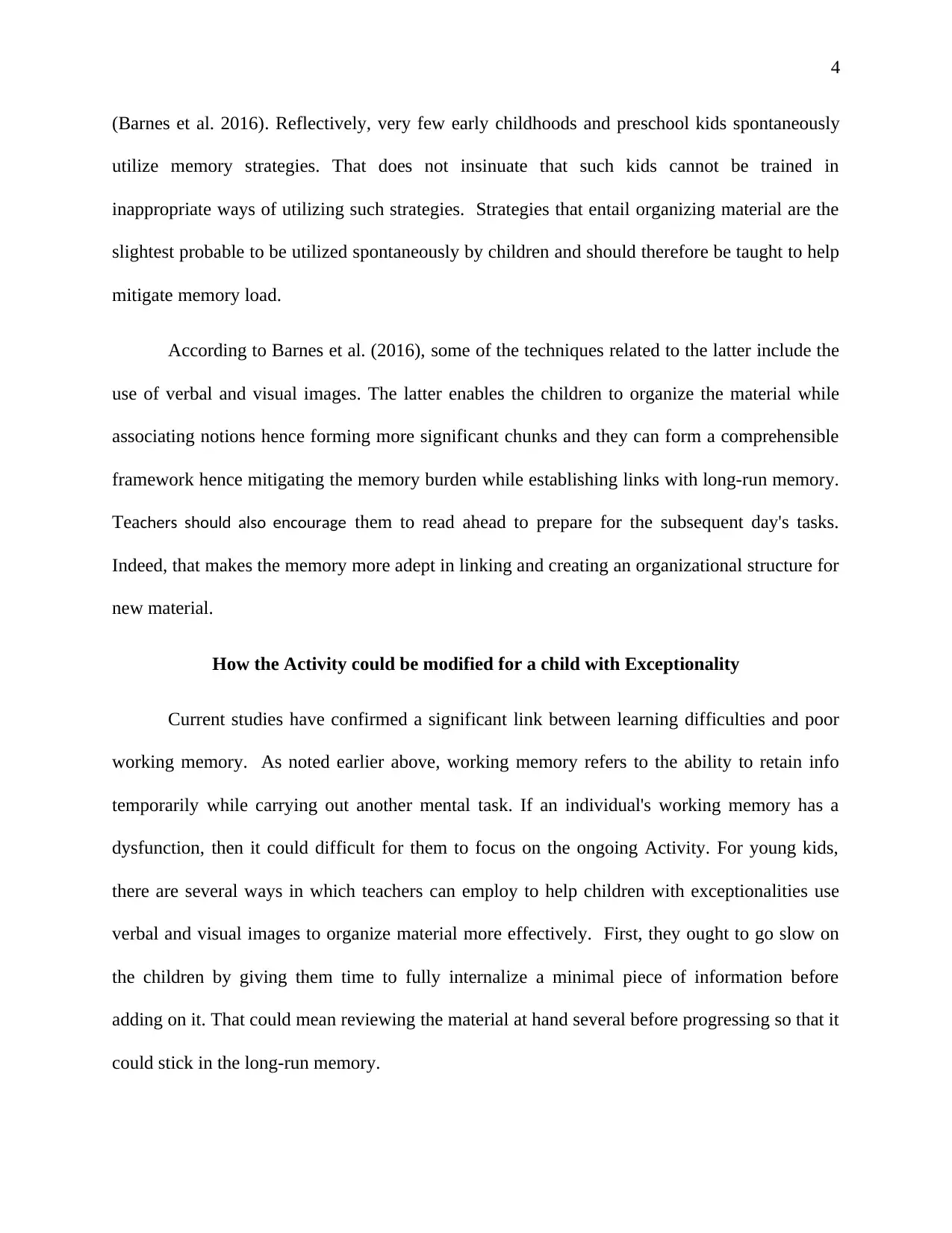
4
(Barnes et al. 2016). Reflectively, very few early childhoods and preschool kids spontaneously
utilize memory strategies. That does not insinuate that such kids cannot be trained in
inappropriate ways of utilizing such strategies. Strategies that entail organizing material are the
slightest probable to be utilized spontaneously by children and should therefore be taught to help
mitigate memory load.
According to Barnes et al. (2016), some of the techniques related to the latter include the
use of verbal and visual images. The latter enables the children to organize the material while
associating notions hence forming more significant chunks and they can form a comprehensible
framework hence mitigating the memory burden while establishing links with long-run memory.
Teachers should also encourage them to read ahead to prepare for the subsequent day's tasks.
Indeed, that makes the memory more adept in linking and creating an organizational structure for
new material.
How the Activity could be modified for a child with Exceptionality
Current studies have confirmed a significant link between learning difficulties and poor
working memory. As noted earlier above, working memory refers to the ability to retain info
temporarily while carrying out another mental task. If an individual's working memory has a
dysfunction, then it could difficult for them to focus on the ongoing Activity. For young kids,
there are several ways in which teachers can employ to help children with exceptionalities use
verbal and visual images to organize material more effectively. First, they ought to go slow on
the children by giving them time to fully internalize a minimal piece of information before
adding on it. That could mean reviewing the material at hand several before progressing so that it
could stick in the long-run memory.
(Barnes et al. 2016). Reflectively, very few early childhoods and preschool kids spontaneously
utilize memory strategies. That does not insinuate that such kids cannot be trained in
inappropriate ways of utilizing such strategies. Strategies that entail organizing material are the
slightest probable to be utilized spontaneously by children and should therefore be taught to help
mitigate memory load.
According to Barnes et al. (2016), some of the techniques related to the latter include the
use of verbal and visual images. The latter enables the children to organize the material while
associating notions hence forming more significant chunks and they can form a comprehensible
framework hence mitigating the memory burden while establishing links with long-run memory.
Teachers should also encourage them to read ahead to prepare for the subsequent day's tasks.
Indeed, that makes the memory more adept in linking and creating an organizational structure for
new material.
How the Activity could be modified for a child with Exceptionality
Current studies have confirmed a significant link between learning difficulties and poor
working memory. As noted earlier above, working memory refers to the ability to retain info
temporarily while carrying out another mental task. If an individual's working memory has a
dysfunction, then it could difficult for them to focus on the ongoing Activity. For young kids,
there are several ways in which teachers can employ to help children with exceptionalities use
verbal and visual images to organize material more effectively. First, they ought to go slow on
the children by giving them time to fully internalize a minimal piece of information before
adding on it. That could mean reviewing the material at hand several before progressing so that it
could stick in the long-run memory.
Paraphrase This Document
Need a fresh take? Get an instant paraphrase of this document with our AI Paraphraser
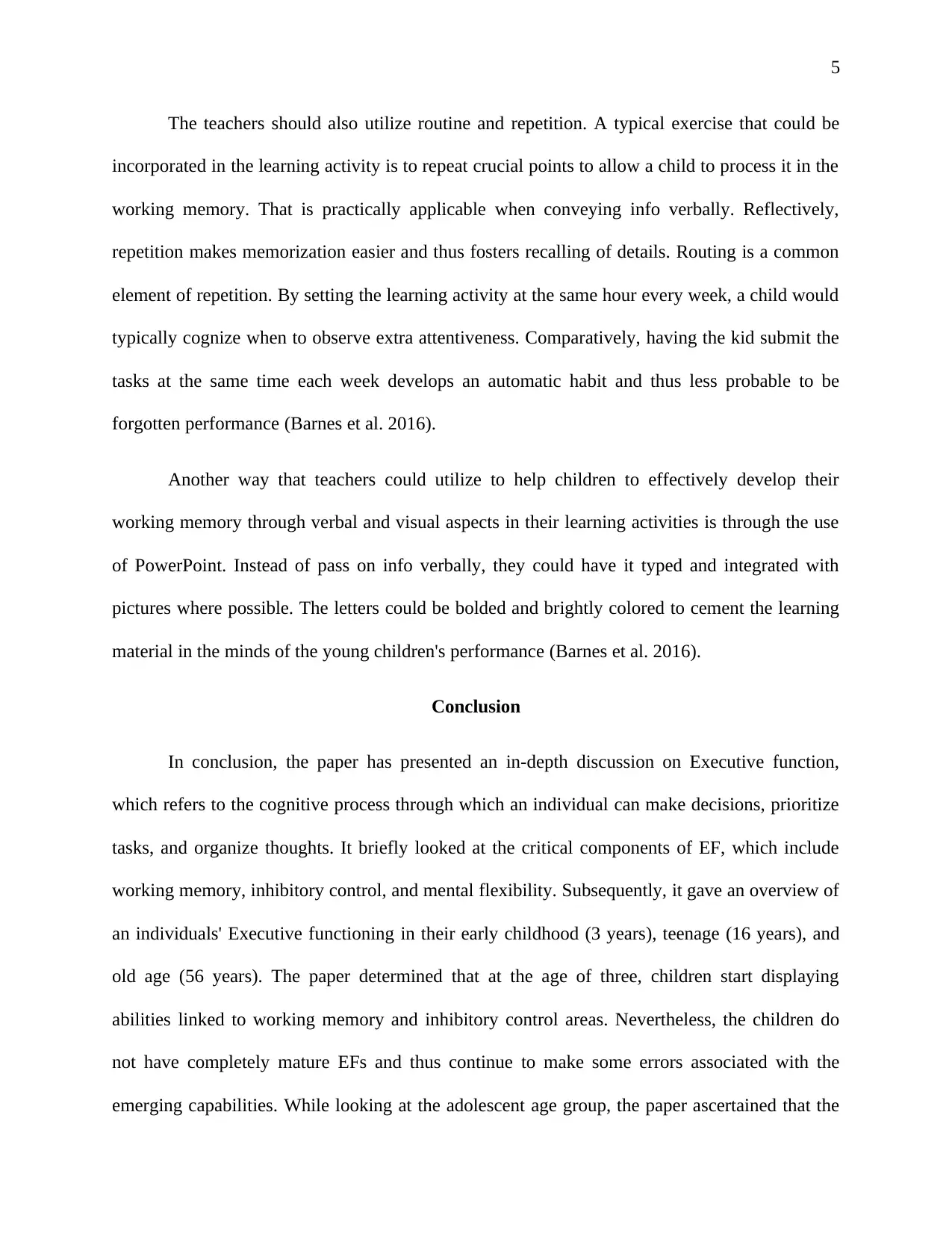
5
The teachers should also utilize routine and repetition. A typical exercise that could be
incorporated in the learning activity is to repeat crucial points to allow a child to process it in the
working memory. That is practically applicable when conveying info verbally. Reflectively,
repetition makes memorization easier and thus fosters recalling of details. Routing is a common
element of repetition. By setting the learning activity at the same hour every week, a child would
typically cognize when to observe extra attentiveness. Comparatively, having the kid submit the
tasks at the same time each week develops an automatic habit and thus less probable to be
forgotten performance (Barnes et al. 2016).
Another way that teachers could utilize to help children to effectively develop their
working memory through verbal and visual aspects in their learning activities is through the use
of PowerPoint. Instead of pass on info verbally, they could have it typed and integrated with
pictures where possible. The letters could be bolded and brightly colored to cement the learning
material in the minds of the young children's performance (Barnes et al. 2016).
Conclusion
In conclusion, the paper has presented an in-depth discussion on Executive function,
which refers to the cognitive process through which an individual can make decisions, prioritize
tasks, and organize thoughts. It briefly looked at the critical components of EF, which include
working memory, inhibitory control, and mental flexibility. Subsequently, it gave an overview of
an individuals' Executive functioning in their early childhood (3 years), teenage (16 years), and
old age (56 years). The paper determined that at the age of three, children start displaying
abilities linked to working memory and inhibitory control areas. Nevertheless, the children do
not have completely mature EFs and thus continue to make some errors associated with the
emerging capabilities. While looking at the adolescent age group, the paper ascertained that the
The teachers should also utilize routine and repetition. A typical exercise that could be
incorporated in the learning activity is to repeat crucial points to allow a child to process it in the
working memory. That is practically applicable when conveying info verbally. Reflectively,
repetition makes memorization easier and thus fosters recalling of details. Routing is a common
element of repetition. By setting the learning activity at the same hour every week, a child would
typically cognize when to observe extra attentiveness. Comparatively, having the kid submit the
tasks at the same time each week develops an automatic habit and thus less probable to be
forgotten performance (Barnes et al. 2016).
Another way that teachers could utilize to help children to effectively develop their
working memory through verbal and visual aspects in their learning activities is through the use
of PowerPoint. Instead of pass on info verbally, they could have it typed and integrated with
pictures where possible. The letters could be bolded and brightly colored to cement the learning
material in the minds of the young children's performance (Barnes et al. 2016).
Conclusion
In conclusion, the paper has presented an in-depth discussion on Executive function,
which refers to the cognitive process through which an individual can make decisions, prioritize
tasks, and organize thoughts. It briefly looked at the critical components of EF, which include
working memory, inhibitory control, and mental flexibility. Subsequently, it gave an overview of
an individuals' Executive functioning in their early childhood (3 years), teenage (16 years), and
old age (56 years). The paper determined that at the age of three, children start displaying
abilities linked to working memory and inhibitory control areas. Nevertheless, the children do
not have completely mature EFs and thus continue to make some errors associated with the
emerging capabilities. While looking at the adolescent age group, the paper ascertained that the
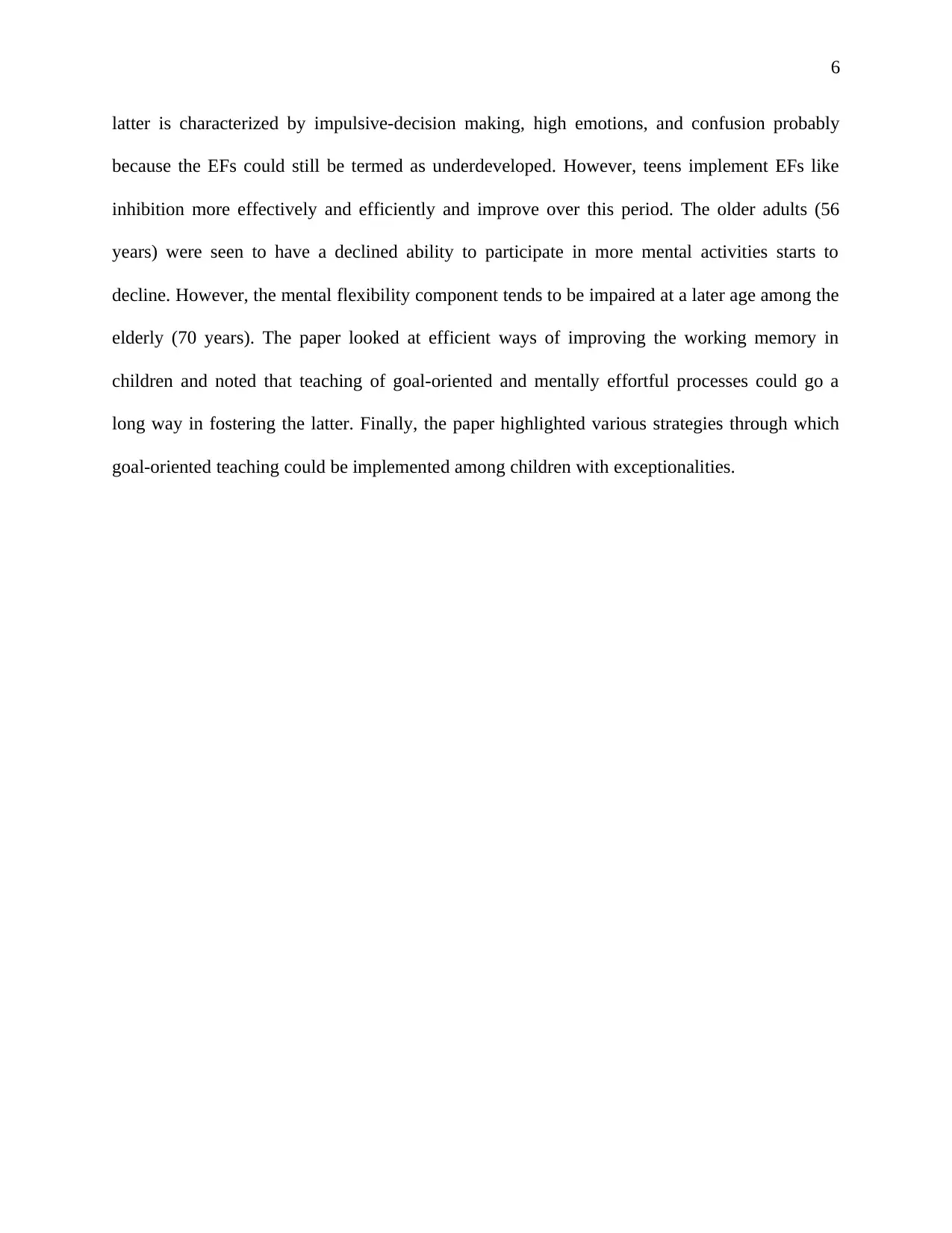
6
latter is characterized by impulsive-decision making, high emotions, and confusion probably
because the EFs could still be termed as underdeveloped. However, teens implement EFs like
inhibition more effectively and efficiently and improve over this period. The older adults (56
years) were seen to have a declined ability to participate in more mental activities starts to
decline. However, the mental flexibility component tends to be impaired at a later age among the
elderly (70 years). The paper looked at efficient ways of improving the working memory in
children and noted that teaching of goal-oriented and mentally effortful processes could go a
long way in fostering the latter. Finally, the paper highlighted various strategies through which
goal-oriented teaching could be implemented among children with exceptionalities.
latter is characterized by impulsive-decision making, high emotions, and confusion probably
because the EFs could still be termed as underdeveloped. However, teens implement EFs like
inhibition more effectively and efficiently and improve over this period. The older adults (56
years) were seen to have a declined ability to participate in more mental activities starts to
decline. However, the mental flexibility component tends to be impaired at a later age among the
elderly (70 years). The paper looked at efficient ways of improving the working memory in
children and noted that teaching of goal-oriented and mentally effortful processes could go a
long way in fostering the latter. Finally, the paper highlighted various strategies through which
goal-oriented teaching could be implemented among children with exceptionalities.
⊘ This is a preview!⊘
Do you want full access?
Subscribe today to unlock all pages.

Trusted by 1+ million students worldwide
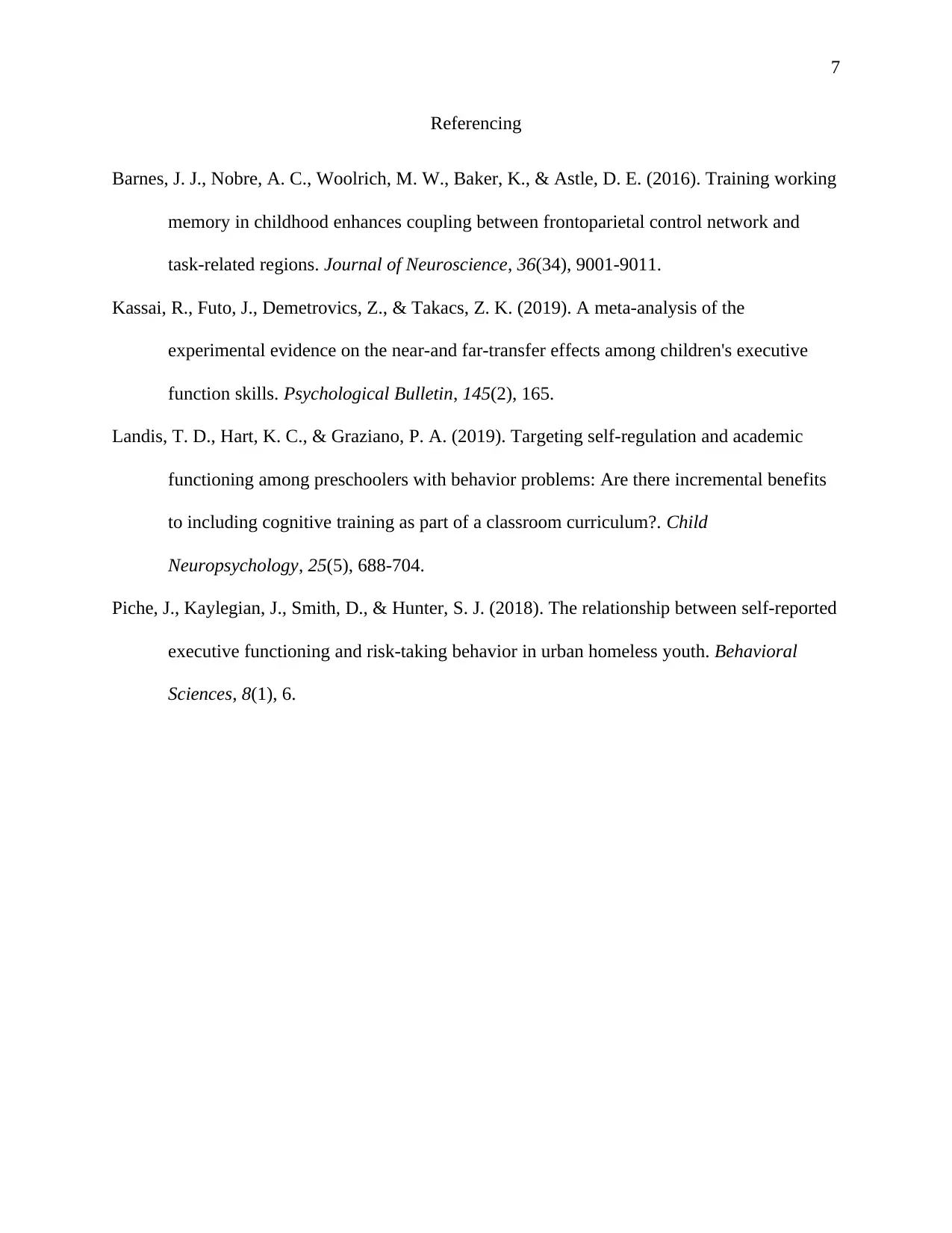
7
Referencing
Barnes, J. J., Nobre, A. C., Woolrich, M. W., Baker, K., & Astle, D. E. (2016). Training working
memory in childhood enhances coupling between frontoparietal control network and
task-related regions. Journal of Neuroscience, 36(34), 9001-9011.
Kassai, R., Futo, J., Demetrovics, Z., & Takacs, Z. K. (2019). A meta-analysis of the
experimental evidence on the near-and far-transfer effects among children's executive
function skills. Psychological Bulletin, 145(2), 165.
Landis, T. D., Hart, K. C., & Graziano, P. A. (2019). Targeting self-regulation and academic
functioning among preschoolers with behavior problems: Are there incremental benefits
to including cognitive training as part of a classroom curriculum?. Child
Neuropsychology, 25(5), 688-704.
Piche, J., Kaylegian, J., Smith, D., & Hunter, S. J. (2018). The relationship between self-reported
executive functioning and risk-taking behavior in urban homeless youth. Behavioral
Sciences, 8(1), 6.
Referencing
Barnes, J. J., Nobre, A. C., Woolrich, M. W., Baker, K., & Astle, D. E. (2016). Training working
memory in childhood enhances coupling between frontoparietal control network and
task-related regions. Journal of Neuroscience, 36(34), 9001-9011.
Kassai, R., Futo, J., Demetrovics, Z., & Takacs, Z. K. (2019). A meta-analysis of the
experimental evidence on the near-and far-transfer effects among children's executive
function skills. Psychological Bulletin, 145(2), 165.
Landis, T. D., Hart, K. C., & Graziano, P. A. (2019). Targeting self-regulation and academic
functioning among preschoolers with behavior problems: Are there incremental benefits
to including cognitive training as part of a classroom curriculum?. Child
Neuropsychology, 25(5), 688-704.
Piche, J., Kaylegian, J., Smith, D., & Hunter, S. J. (2018). The relationship between self-reported
executive functioning and risk-taking behavior in urban homeless youth. Behavioral
Sciences, 8(1), 6.
1 out of 7
Your All-in-One AI-Powered Toolkit for Academic Success.
+13062052269
info@desklib.com
Available 24*7 on WhatsApp / Email
![[object Object]](/_next/static/media/star-bottom.7253800d.svg)
Unlock your academic potential
Copyright © 2020–2025 A2Z Services. All Rights Reserved. Developed and managed by ZUCOL.

